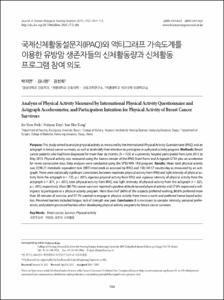국제신체활동설문지(IPAQ)와 액티그래프 가속도계를 이용한 유방암 생존자들의 신체활동량과 신체활동 프로그램 참여 의도
- Keimyung Author(s)
- Kim, Na Hyun; Kang, Sun Hee
- Department
- Dept. of Nursing (간호학)
Dept. of Surgery (외과학)
Research Institute for Nursing Science (간호과학연구소)
- Journal Title
- Journal of Korean Biological Nursing Science
- Issued Date
- 2015
- Volume
- 17
- Issue
- 2
- Keyword
- Breast cancer; Survivor; Physical activity
- Abstract
- Purpose: This study aimed to analyze physical activity as measured by the International Physical Activity Questionnaire (IPAQ) and an actigraph in breast cancer survivors, as well as to identify their intention to participate in a physical activity program. Methods: Breast cancer patients who had been diagnosed for more than six months (N=135) at a university hospital participated from June 2012 to May 2013. Physical activity was measured using the Korean version of the IPAQ-Short Form and Actigraph GT3X plus an accelerator for seven consecutive days. Data analyses were conducted using the SPSS WIN 19.0 program. Results: Mean total physical activity was 2298.21 metabolic equivalent task (MET)-min/week as assessed by IPAQ and 150,140.57 counts/day as measured by an actigraph. There were statistically significant correlations between moderate physical activity from IPAQ and light intensity of physical activity from the actigraph (r=.735, p<.001), vigorous physical activity from IPAQ and vigorous intensity of physical activity from the actigraph (r=.871, p<.001), total physical activity from IPAQ and light intensity of physical activity from the actigraph (r=.825, p<.001), respectively. Most (80.7%) cancer survivors reported a positive attitude toward physical activity and 57.8% expressed a willingness to participate in a physical activity program. More than half (60%) of the subjects preferred walking, 80.6% preferred more than 30 minutes of exercise, and 57.1% wanted to engage in physical activity three times a week and preferred home-based activities. Perceived barriers included fatigue, lack of strength and pain. Conclusion: It is necessary to consider intensity, personal preferences, and patient-perceived barriers when developing physical activity programs for breast cancer survivors.
- Alternative Title
- Analysis of Physical Activity Measured by International Physical Activity Questionnaire and Actigraph Accelerometer, and Participation Intention for Physical Activity of Breast Cancer Survivors
- Publisher
- College of Nursing
- Citation
- 박지연 et al. (2015). 국제신체활동설문지(IPAQ)와 액티그래프 가속도계를 이용한 유방암 생존자들의 신체활동량과 신체활동 프로그램 참여 의도. Journal of Korean Biological Nursing Science, 17(2), 104–113. doi: 10.7586/jkbns.2015.17.2.104
- Type
- Article
- ISSN
- 1229-6155
- 파일 목록
-
-
Download
 oak-aaa-2890.pdf
기타 데이터 / 506.23 kB / Adobe PDF
oak-aaa-2890.pdf
기타 데이터 / 506.23 kB / Adobe PDF
-
Items in Repository are protected by copyright, with all rights reserved, unless otherwise indicated.